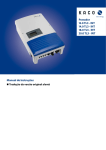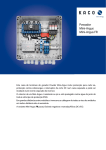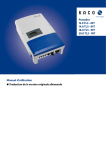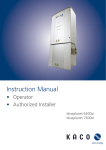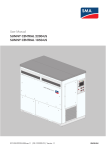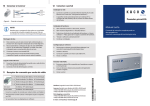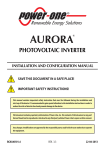Download KACO Powador 5300 Inverter User manual
Transcript
Powador
3200 | 4200
4400 | 5300
5300 supreme
5500 | 6600
Operating Instructions
English translation of German
original
Operating Instructions
for Installers and Operators
Powador
3200 | 4200
4400 | 5300
5300 supreme
5500 | 6600
Contents
1
General Notes ............................................ 4
8
Configuration and Operation................ 35
1.1
About this documentation .................................4
8.1
Controls....................................................................35
1.2
Layout of Instructions ...........................................4
8.2
Initial start-up ........................................................38
2
Safety ......................................................... 6
8.3
Menu structure......................................................39
2.1
Proper use .................................................................6
9
Maintenance/Troubleshooting.............. 45
2.2
Protection features ................................................ 7
9.1
Visual inspection ..................................................45
2.3
Standards and directives ..................................... 7
9.2
Cleaning the inverter externally .....................45
3
Description ................................................ 8
9.3
3.1
Mode of Operation ................................................8
Shutting down for maintenance and
troubleshooting ................................................... 46
3.2
Description of the unit .........................................8
9.4
Faults........................................................................ 46
4
Technical Data ..........................................15
9.5
Messages on the display
and the “Fault” LED............................................. 49
4.1
Electrical Data .........................................................15
10
Service...................................................... 53
4.2
Mechanical data.....................................................17
11
Shutdown/Disassembly ......................... 54
5
Transportation and Delivery.................. 18
11.1
Shutting down the inverter ..............................54
5.1
Delivery .................................................................... 18
11.2
Deinstalling the inverter ....................................54
5.2
Transportation ....................................................... 18
11.3
Dismantling the inverter....................................54
6
Mounting the Inverter .............................19
12
Disposal ................................................... 54
6.1
Installing and securing the inverter................21
12.1
Packaging................................................................54
7
Installing the Inverter ............................. 22
13
Documents .............................................. 55
7.1
Opening the connection area .........................22
13.1
EU Declaration of Conformity .........................55
7.2
Making the electrical connection ..................22
7.3
Connecting the interfaces ................................ 27
7.4
Limiting during asymmetric
feed to the grid .....................................................29
7.5
Sealing the connection area ............................34
7.6
Starting up the inverter......................................34
Operating Instructions Powador 3200-6600_EN
Page 3
G ener a l N o te s
1
General Notes
1.1
About this documentation
WARNING
Improper handling of the inverter can be hazardous
› You must read and understand the operating instructions before you can install and use the
inverter safely.
1.1.1
Other applicable documents
During installation, observe all assembly and installation instructions for components and other parts of the system.
These instructions are delivered together with the respective components and other parts of the system.
1.1.2
Storing the documents
These instructions and other documents must be stored near the system and be available at all times.
1.2
Layout of Instructions
1.2.1
Symbols used
General hazard
Risk of fire or explosion
High voltage!
Risk of burns
Authorised electrician Only authorised electricians may carry out tasks indicated with this symbol.
1.2.2
Safety warnings symbols guide
DANGER
High risk
Failure to observe this warning will lead directly to serious bodily injury or death.
WARNING
Potential risk
Failure to observe this warning may lead to serious bodily injury or death.
CAUTION
Low-risk hazard
Failure to observe this warning will lead to minor or moderate bodily injury.
CAUTION
Risk of damage to property
Failure to observe this warning will lead to property damage.
Page 4
Operating Instructions Powador 3200-6600_EN
G ener a l N o te s
1.2.3
Additional information symbols
NOTE
Useful information and notes
DE
1.2.4
Country-specific function
Functions restricted to one or more countries are labelled with country codes in accordance with
ISO 3166-1.
Instructions symbols guide
a) Single step instructions or instructions that can be carried out in any sequence:
Instructions
↻ Prerequisite(s) for the step(s) (optional)
Carry out the next step.
(Additional steps, if applicable)
»
Result of the step(s) (optional)
b) Multi-step instructions that must be carried out in a fixed sequence:
Instructions
↻ Prerequisite(s) for the steps (optional)
1.
Carry out the next step.
2.
Carry out the next step.
3.
(Additional steps, if applicable)
»
Result of the steps (optional)
1.2.5
Abbreviations
PV
Photovoltaic
EEG
German Renewable Energies Act
MPP
Maximum power point (point of the current-voltage diagram of a PV generator at which the maximum
amount of power can be drawn)
Colour codes (in accordance with IEC 60757)
BK
Black
BN
Brown
BU
Blue
GNYE
Yellow-green
GY
Grey
Operating Instructions Powador 3200-6600_EN
Page 5
Sa fety
2
Safety
DANGER
Lethal voltages are still present in the terminals and cables of the inverter even after the
inverter has been switched off and disconnected.
Severe injuries or death will occur if the cables and terminals in the inverter are touched.
Only authorised electricians who are approved by the supply grid operator may open, install or
maintain the inverter.
› Keep the inverter closed when the unit is in operation.
› Do not touch the cables or terminals when switching the unit on and off.
› Do not make any modifications to the inverter.
The electrician is responsible for observing all existing standards and regulations.
• Keep unauthorised persons away from the inverter and PV system.
• Be sure to observe IEC 60364-7-712:2002 “Requirements for special installations or locations – solar photovoltaic
(PV) power supply systems” in particular.
• Ensure operational safety by providing proper grounding, conductor dimensioning and appropriate protection
against short circuiting.
• Observe the safety instructions on the inverter and in these operating instructions.
• Switch off all voltage sources and secure them against being inadvertently switched back on before performing
visual inspections and maintenance.
• When taking measurements while the inverter is live:
– Do not touch the electrical connections.
– Remove all jewellery from your wrists and fingers.
– Ensure that the testing equipment is in safe operating condition.
• Stand on an insulated surface when working on the inverter while it is switched on.
• Modifications to the surroundings of the inverter must comply with the applicable national and local standards.
• When working on the PV generator, it is also necessary to switch off the DC voltage with the DC disconnect in
addition to disconnecting the PV generator from the grid.
2.1
Proper use
The inverter converts the DC voltage generated by the PV modules into AC voltage and feeds it into the grid. The
inverter is built according to the latest technological standards and safety regulations. Nevertheless, improper use
may cause lethal hazards for the operator or third parties, or may result in damage to the unit and other property.
Operate the inverter only with a permanent connection to the public power grid.
Any other or additional use of the device is deemed improper. This includes:
• Mobile use
• Use in rooms where there is a risk of explosion
• Use in rooms where the humidity is higher than 95%
• Operation outside of the specifications intended by the manufacturer
• Standalone operation
Page 6
Operating Instructions Powador 3200-6600_EN
Sa fety
2.2
Protection features
For your safety, the following monitoring and protective functions are integrated into Powador inverters:
• Overvoltage conductors/varistors to protect the power semiconductors from high-energy transients on the grid
and generator side
• Temperature monitoring of the heat sink
• EMC filters to protect the inverter from high-frequency grid interference
• Grid-side grounded varistors to protect the inverter against burst and surge pulses
• Islanding detection according to VDE 0126-1-1
2.3
Standards and directives
NOTE
The EU declaration of conformity can be found in the appendix.
For information on grid coupling, grid protection and safety parameters along with more detailed
instructions see our web site at http://www.kaco-newenergy.de/.
Operating Instructions Powador 3200-6600_EN
Page 7
Desc r iptio n
3
Description
3.1
Mode of Operation
The inverter converts the DC voltage generated by the PV modules into AC voltage and feeds it into the grid. The
feed-in process begins when there is sufficient sunlight and a specific minimum voltage is present in the inverter.
If, as it gets dark, the voltage drops below the minimum voltage value, feed-in operation ends and the inverter
switches off.
3.2
Description of the unit
3.2.1
Powador inverter as part of a PV system
3.2.1.1
System layout
PV generator
PV generator
Inverter with DC
disconnect
Inverter with DC
disconnect
Fuse
Fuse
Consumer
Reference
counter
KWh
Main switch
KWh
Feed-in meter
Selective
main switch
Grid connection point
Figure 1: Overview circuit diagram for a system with two inverters
Page 8
Operating Instructions Powador 3200-6600_EN
Desc r iptio n
3.2.2
System with multiple inverters
3.2.2.1
Asymmetric feed-in
1
2
3
4
L1 N PE
L1 N PE
L1 N PE
L1 N PE
n
PV generator
Inverters
Fuse
L1
L2
L3
N
Figure 2: Grid-side connection for systems with multiple inverters with single-phase grid monitoring
3.2.2.2 Three-phase grid monitoring
1
2
3
4
L3 L2 L1 N PE
L3 L2 L1 N PE
L3 L2 L1 N PE
L3 L2 L1 N PE
n
PV generator
Inverters
WR1 : L3 - L3 / L2 - L2 / L1 - L1
WR2 : L3 - L1 / L2 - L3 / L1 - L2
WR3 : L3 - L2 / L2 - L1 / L1 - L3
WR4 : L3 - L3 / L2 - L2 / L1 - L1
.........
Fuse
L1
L2
L3
N
Figure 3: Grid-side connection for systems with multiple inverters with three-phase grid monitoring
3.2.2.3 Electrical connection
NOTE
Note the grid type-specific connection conditions (see section 7.2.1 on page 23).
Operating Instructions Powador 3200-6600_EN
Page 9
Desc r iptio n
3.2.3
Summary of the components
PV generator
The PV generator, i.e. the PV modules, converts the radiant energy of sunlight into electrical energy.
DC terminal point
Options for parallel connections of several generator strings:
• To a DC terminal point between the DC generator and inverter
• Directly to the inverter (terminals for 3 strings are provided on the inverter)
• Directly to the PV generator with a positive and negative lead to the inverter
DC disconnect
Use the DC disconnect to disconnect the inverter from all power sources on the PV generator side.
Grid fuses
gL fuses are suitable.
Feed-in meter
The feed-in meter is to be specified and installed by the power supply company. Some power supply companies
also allow the installation of your own calibrated meters.
Selective main switch
If you have questions about the selective main switch, contact your power supply company.
3.2.4
Inverter diagram
12
3
45
6
9
8
7
Figure 4: Inverter diagram
Key
1
Display
6
Cable fitting for DC connection
2
LED indicators
7
Cable fitting for interface cable
3
Control buttons
8
Cable fitting for AC connection
4
DC disconnect
9
Night start button
5
RS232 port
Page 10
Operating Instructions Powador 3200-6600_EN
Desc r iptio n
3.2.5
Electrical functions
3.2.5.1
Fault signal relay
A potential-free relay contact is integrated in the inverter. The contact closes as soon as there is a fault during
operation.
For connection see section 7.3.1 on page 27.
DE
Country-specific function
3.2.5.2
Fault signal relay/Powador-priwatt
A potential-free relay contact is integrated in the inverter. Use this contact for one of the following
functions:
• Fault signal relay
• Powador-priwatt
Powador-priwatt
The energy that is provided by the PV system can be put to use directly by the appliances that are
connected in your home. In “Powador-priwatt” mode, the potential-free contact takes care of this
function.
The contact closes if sufficient PV energy is available over a period of 30 minutes. When the contact
closes, a visual or acoustic signal is emitted, e.g. from a signal lamp or siren (optional).
Activating the function (optional)
The “Powador-priwatt” function is not active in the unit’s factory default state. You can obtain the
password for the function from your specialist retailer. The electrician then activates the function in
the configuration menu (see section 8.3 on page 39).
Powador-priwatt switch (optional)
The potential-free contact switches larger appliances (e.g. air conditioning units) on and off. This
requires an external power supply (max. 30 V DC) and an external load relay.
Both can be obtained as part of the Powador-priwatt switch from your specialist retailer.
DE
Country-specific function
3.2.5.3
Power limitation (power control)
Since 1 January 2009, the German Renewable Energies Act (EEG) requires power limitation for systems
with an output of more than 100 kW. This limit value can be exceeded when using a unit group of
several inverters. Therefore, each inverter must have an option for limiting power, even if this is not
needed in a system that is smaller than 100 kW.
The power reduction is achieved using a ripple control receiver in KACO new energy GmbH inverters.
If necessary, the power supply company can reduce the power of the system remotely using an
additional device from the Powador proLOG family. The Powador-proLOG activates this function,
which is already integrated in the inverter. After a specified period of time without any signal from the
power supply company, the inverter returns to normal operation. For information about PowadorproLOG, contact your specialist retailer.
Levels of AC power reduction
Inverter action
100%
Normal feed-in mode
60 %
Limitation of power to 60%
30 %
Limitation of power to 30 %
0%
Disconnection from the grid
Operating Instructions Powador 3200-6600_EN
Page 11
Desc r iptio n
DE NSp.
Country-specific function
3.2.5.4 Control procedure cos phi (P/Pn)
The control procedure cos phi (P/Pn) offers the option of defining up to 10 nodes (minimum of 2) for
shift factor cos phi. A node is defined by the relevant pair of values (Specification of an active power
in % based on a nominal power of the device and an associated cos phi value.)
In factory status cos phi is activated with a predefined characteristic.
This characteristic, which consists of three individual nodes, depends on the rated AC power of the
inverter.
cos φ
0.9
o (overexcited)
1
0,2
0.9
0,5
1
P /Pn
u (underexcited)
Characteristic with 2 nodes
Characteristic with 3 nodes
Figure 5: Control procedure as per cos phi (P/pn)
PAC,nom < 13.8 kVA
1st node 0% P/PN - - cos phi 1000
2nd Node 50% P/PN - - cos phi 1.000
3rd node 100% P/PN - - cos phi 0.950 under-excited (u)
To meet the requirements for reactive power feed even at system level, the inverters must be
adjustable in the range from cos phi 0.8 over-excited (o) and 0.8 under-excited (u).
Page 12
Operating Instructions Powador 3200-6600_EN
Desc r iptio n
3.2.6
Mechanical components
3.2.6.1
DC disconnect
There is one DC disconnect inside the inverter housing. The DC disconnect is used to disconnect the inverter from
the PV generator in order to carry out service.
Disconnecting the inverter from the PV generator
Switch the DC disconnects from 1 (ON) to 0 (OFF).
Connecting the inverter to the PV generator
Switch the DC disconnects from 0 (OFF) to 1 (ON).
Figure 6: DC disconnect
3.2.6.2 Night start button
The unit switches off in the evening as nightfall approaches. At this point, nothing is shown on the display. In order
to retrieve the values from the current day (daily yield, daily hours of operation and max. feed-in power) after
the display switches off, the unit can also be activated during the night by pressing the night start-up key on the
underside of the inverter.
Figure 7: Night-start interface on the inverter
3.2.7
Interfaces
The inverter has the following interfaces for communication and remote monitoring:
• RS232 port
• RS485 interface
• S0 interface
You configure the interfaces in the Settings menu (see section 8.3 on page 39).
3.2.7.1
RS232 port
Use this monitoring variant if you wish to manage operating data directly on a computer. The data can be processed
with standard spreadsheet programs.
The inverter and computer are connected with a serial 1:1 interface cable.
The cable length should not exceed 20 metres.
The data from the inverter is sent unidirectionally as pure ASCII text over the serial interface. The data is not checked
for errors.
The RS232 interface has the following parameters:
Baud rate
Data bits
Parity
Stop bits
Protocol
9600 baud
8
None
1
None
Table 1 on page 14 shows an example of a few lines of data transmitted over the RS232 interface
Operating Instructions Powador 3200-6600_EN
Page 13
Desc r iptio n
Spalte 1
2
3
00.00.0000 00:05:30 3
00.00.0000 00:05:40 3
00.00.0000 00:05:50 3
00.00.0000 00:06:00 3
00.00.0000 00:06:10 3
00.00.0000 00:06:20 3
00.00.0000 00:06:30 3
00.00.0000 00:06:40 3
Table 1:
4
363.8
366.0
359.5
369.8
377.0
373.6
364.0
364.3
5
0.37
0.39
0.41
0.42
0.43
0.45
0.48
0.49
6
134
142
147
155
162
168
174
178
7
226.1
226.1
226.1
226.1
226.1
226.1
226.1
226.1
8
0.53
0.53
0.53
0.58
0.63
0.63
0.68
0.68
9
10
103 23
112 23
116 23
118 23
131 23
133 23
146 23
146 23
Excerpt from the RS232 interface transmission log
Key
Column
Meaning
Column
Meaning
1
Placeholder
6
Generator power in W
2
Daily running time
7
Line voltage in V
3
Operating state (see section 8.1 on page 35)
8
Line current, feed-in current in A
4
Generator voltage in V
9
Power fed into the grid in W
5
Generator current in A
10
Temperature of the unit in °C
3.2.7.2
Software for direct monitoring
Together with the Powador inverter, KACO-viso takes over the role of a data logger. It saves the data from the
inverter and displays it in various diagram types as a daily or monthly representation.
The PC, however, must also run continuously. Because of the amount of energy used, this type of monitoring only
makes sense over limited periods, such as during a fault analysis. For permanent system monitoring, we recommend
the optional accessories (see page 14). (Powador-proLOG)
3.2.7.3
RS485 interface
Use this monitoring option if you cannot check the functioning of the system on-site on a regular basis, e.g. if
your place of residence is located a great distance from the system. To connect the RS485 interface, contact your
authorised electrician.
For monitoring your PV system using the RS485 interface, KACO new energy GmbH offers the following units:
Powador-proLOG S to XL (optional)
Powador-proLOG allows you to monitor up to 31 inverters simultaneously. Depending on the product model,
Powador-proLOG sends yield and operating data by SMS or e-mail.
Powador-link RS485 (optional)
Use the Powador-link RS485 to bridge long distances between several inverters or between an inverter and the
Powador-proLOG by means of wireless radio transmission.
3.2.7.4
S0 interface
The S0 interface transmits pulses between a pulsing counter and a tariff metering unit. It is a galvanically isolated
transistor output. It is designed according to DIN EN 62053-31:1999-04 (pulse output devices for electromechanical
and electronic meters).
NOTE
The S0 interface pulse rate can be chosen in three unit intervals (500, 1,000 and 2,000 pulses/kWh).
3.2.7.5
Digital input
If a Powador protect is installed as external grid and system protection, the fail-safe disconnection of suitable
Powador inverters from the public grid can be initiated by a digital signal instead of by tie circuit-breakers. This
requires the inverters in the photovoltaic system to be connected to the Powador protect. For information on
the installation and use see this manual, the Powador protect manual and the instructions for use of the Powador
protect on the web site.
Page 14
Operating Instructions Powador 3200-6600_EN
T echnic a l Dat a
4
Technical Data
4.1
Electrical Data
Input levels
3200
4200
4400
5300
Max. recommended PV generator power [W]
3 200
4 200
4 400
5 300
DC MPP range from [V] to [V]
350...600
Operating range from [V] to [V]
370 to 500
Starting voltage [V]
410
Open circuit voltage [V]
800
Max. rated current [A]
Max. power per tracker [W]
8.6
11.5
12
14.5
3 200
4 200
4 400
5 250
Number of strings
3
Number of MPP controls
1
Polarity safeguard
Short-circuit diode
Output levels
Rated power [VA]
2 600
3 450
3 600
4 400
Max. rated power [VA]
2 850
3 800
4 000
4 800
Grid voltage [V]
184 - 264
Rated current [A]
11.3
15
15.6
19.1
Max. rated current [A]
12.4
16.5
17.5
20.9
Rated frequency [Hz]
50 / 60
cos phi
0.80 over-excited ... 0.80 under-excited
Number of feed-in phases
1
General electrical data
Max. efficiency [%]
96.6
96.6
96.5
96.4
European efficiency [%]
95.8
95.8
95.9
95.8
Internal consumption: night [W]
Feed-in starts at [W]
Circuit design
0
Approx. 35
Transformerless
Transformer unit
No
Grid monitoring
Country-specific
CE conformity
Operating Instructions Powador 3200-6600_EN
yes
Page 15
T echnic a l Dat a
Input levels
Max. recommended PV generator power [W]
DC MPP range from [V] to [V]
5300 supreme
5500
6600
5 300
5 500
6 600
350...510
350...600
350...600
Operating range from [V] to [V]
370 to 500
Starting voltage [V]
410
Open circuit voltage [V]
600
800
800
Max. rated current [A]
14.5
15.2
18
Max. power per tracker [W]
5 250
6 000
6 800
Number of strings
3
Number of MPP controls
1
Polarity safeguard
Short-circuit diode
Output levels
Rated power [VA]
4 400
4 600
5 500
Max. rated power [VA]
4 800
5 060
6 000
Grid voltage [V]
190 - 264
Rated current [A]
19.1
20
23.9
Max. rated current [A]
20.9
22
26
Rated frequency [Hz]
cos phi
50 / 60
0.80 over-excited ... 0.80 under-excited
Number of feed-in phases
1
General electrical data
Max. efficiency [%]
97.2
(97.6 @ 9 kHz)
96.3
96.3
European efficiency [%]
96.6
(97.1 @ 9 kHz)
95.7
95.8
Internal consumption: night [W]
Feed-in starts at [W]
Circuit design
0
Approx. 35
Transformerless
Transformer unit
No
Grid monitoring
Country-specific
CE conformity
Table 2:
Page 16
yes
Electrical data
Operating Instructions Powador 3200-6600_EN
T echnic a l Dat a
4.2
Mechanical data
3200
4200
4400
5300
5300
supreme
5500
LEDs: PV generator (green) , supply (green) , fault (red)
LCD (2 x 16 characters)
Visual displays
Controls
2 keys for operating display
DC disconnect
Integrated DC disconnect with rotary switch
Interfaces
RS232, RS485, S0
Fault signal relay
Potential-free NO contact max. 30V / 3A
230 V / 1 A
AC connections:
PCB terminal
inside the unit (max. cross section: 10 mm²)
AC connections:
Cable connection
Cable connection via M32 cable fitting
DC connections
Cable connection via M16 cable fitting
Ambient temperature
range [°C]
-20 to 60
Humidity range (noncondensing) [%]
0 to 95
Maximum
installation elevation [m
above sea level]
2 000
Temperature monitoring
yes
Cooling
(free convection (K) / fan
(L))
K
Protection rating
according to EN 60529
IP54
Degree of contamination
2
Noise emission [dB(A)]
< 35 / noiseless
Housing
Cast aluminium
H x W x D [mm]
Total weight [kg]
Table 3:
6600
500 x 340
x 200
550 x 340
x 200
550 x 340
x 220
550 x 340
x 220
550 x 340
x 220
600 x 340
x 220
600 x 340
x 220
19
21
21
26
26
28
30
Mechanical data
Operating Instructions Powador 3200-6600_EN
Page 17
T r a nspo r ta ti on and De live ry
5
Transportation and Delivery
5.1
Delivery
Every inverter leaves our factory in proper electrical and mechanical condition. Special packaging ensures that the
units are transported safely. The shipping company is responsible for any transport damage that occurs.
5.1.1
•
•
•
•
Scope of delivery
Powador inverter
Wall bracket
Installation kit
Documentation
Checking your delivery
1. Inspect your inverter thoroughly.
2. Immediately notify the shipping company in case of the following:
– Damage to the packaging that indicates that the inverter may have been damaged
– Obvious damage to the inverter
3. Send a damage report to the shipping company immediately.
The damage report must be received by the shipping company in writing within six days following receipt of the
inverter. We will be glad to help you if necessary.
5.2
Transportation
WARNING
Impact hazard, risk of breakage to the inverter
› Pack the inverter securely for transport.
› Carefully transport the inverter using the the carrying handles of the boxes.
› Do not subject the inverter to shocks.
For safe transportation of the inverter, use the holding openings in the carton.
Figure 8: Transportation of the inverter
Page 18
Operating Instructions Powador 3200-6600_EN
Mounting th e Inve rt e r
Authorised electrician
6
Mounting the Inverter
DANGER
Risk of fatal injury from fire or explosions
Fire caused by flammable or explosive materials in the vicinity of the inverter can lead to serious
injuries.
› Do not mount the inverter in an area at risk of explosion or in the vicinity of highly flammable
materials.
CAUTION
Risk of burns from hot housing components.
Coming into contact with the housing can cause burns.
› Mount the inverter so that it cannot be touched unintentionally.
Installation space
•
•
•
•
•
•
As dry as possible, climate-controlled, with the waste heat dissipated away from the inverter
Unobstructed air circulation
When installing the unit in a control cabinet, provide forced ventilation so that the heat is sufficiently dissipated
Easily accessible from the front and sides
Protected from direct sunlight and moisture (rain) in outdoor areas
For easy operation, ensure during installation that the display is slightly below eye level.
Installation location
•
•
•
•
•
•
•
Free-standing installation or wall mounting possible
Consisting of non-cracked cement
With sufficient load-bearing capacity
Accessible for installation and maintenance
Made from heat-resistant material (up to 90 °C)
Flame resistant
Minimum clearances for assembly: see Figure 9 and Figure 10 on page 20 and Figure 11 on page 21.
CAUTION
Property damage by gases that have an abrasive effect on surfaces in combination with
humidity resulting from weather conditions
The inverter housing may be severely damaged by gases (ammonia, sulphur, etc.) when they
come into
contact with ambient humidity caused by weather conditions.
If the inverter is exposed to gases, it must be mounted so that it can be seen at all times.
› Perform regular visual inspections.
› Immediately remove any moisture from the housing.
› Take care to ensure sufficient ventilation of the inverter.
› Immediately remove dirt, especially on vents.
› Failure to observe these warnings may lead to inverter damage which is not covered by the KACO
new energy GmbH manufacturer warranty.
Operating Instructions Powador 3200-6600_EN
Page 19
Mounting th e Inve rt e r
Authorised electrician
NOTE
Power reduction due to heat accumulation.
If the recommended minimum clearances are not observed, the inverter may go into power
regulation mode due to insufficient ventilation and the resulting heat buildup.
› Maintain minimum clearances.
› Provide for sufficient heat dissipation.
405
565
1386
328
1120
Figure 9: Instructions for wall mounting
Figure 10: Drill stencil for wall mounting with minimum clearances
(in mm)
CAUTION
Use suitable mounting parts.
› Use only the supplied mounting parts.
› Mount the inverter upright on a vertical wall only.
Page 20
Operating Instructions Powador 3200-6600_EN
Mounting th e Inve rt e r
Authorised electrician
Clearance from the ceiling: 500 mm
5
Clearance from any other inverter: 700 mm
1
4
2
3
25
0m
m
25
Safety catch (open)
0m
Safety catch (closed)
m
Clearance from the floor 500 mm
Clearance from any other inverter: 700 mm
Figure 11: Minimum clearances/mounting plate
Key
1
Fixings for mounting
4
Suspension bracket
2
Mounting plate
5
Safety catch
3
Screws for mounting
6.1
Installing and securing the inverter
Mounting the Inverter
1. Mark the positions of the drill holes using the cut-outs in the mounting plate.
NOTE: The minimum clearances between two inverters, or the inverter and the ceiling/floor have already been
taken into account in the diagram (see Figure 10 on page 20) .
2. Fix mounting plate to the wall with the supplied mounting fixtures.
Make sure that the mounting plate is oriented correctly.
3. Hang the inverter on the mounting plate using the suspension brackets on the back of the housing.
4. Secure the inverter with safety catch.
» The mounting of the inverter is complete. Continue with the installation.
Operating Instructions Powador 3200-6600_EN
Page 21
I n sta lling the Inve rt e r
Authorised electrician
7
Installing the Inverter
DANGER
Lethal voltages are still present in the terminals and cables of the inverter even after the
inverter has been switched off and disconnected.
Severe injuries or death will occur if the cables and terminals in the inverter are touched.
Only authorised electricians who are approved by the supply grid operator may open and install the
inverter.
The inverter must be mounted in a fixed position before being connected electrically.
› Observe the safety regulations and current technical connection specifications of the responsible
power supply company.
› Disconnect the AC and DC sides.
› Secure both sides against being inadvertently switched back on.
› Ensure that the AC and DC sides are completely voltage-free.
› Connect the inverter only after the aforementioned steps have been taken.
7.1
Opening the connection area
Opening the connection area
↻ You have mounted the inverter.
1.
2.
Unscrew the two Philips screws on the right-hand side of the housing.
Open the housing door.
»
Make the electrical connection.
7.2
Making the electrical connection
Make the connection to the PV generator as well as the grid connection via the PCB terminals in the connection area
of the inverter. Note the following conductor cross-sections:
AC connection DC connection
Max. conductor cross-section without wire sleeves
16 mm²
10 mm²
Max. conductor cross-section with wire sleeves
10 mm²
6 mm²
Length of insulation to be stripped off
10 mm
15 mm
Tightening torque
4-4.5 Nm
-
A screwdriver (slotted, 3.5 mm) is to be used for the terminals in the inverter. Put the screwdriver into the cut-out
provided. Press the screwdriver upwards slightly. Feed the cable into the spring terminal. Put the screwdriver back
into the original position. Remove the screwdriver. The spring terminal is closed and the cable is held in place.
The power section has two internal circuit board fuses. These are labelled F2 and F861 on the circuit board.
3200-6600
Fuse
F2 type 179120 5x20 slow-blow 250 V / 0.250 A
Vendor
SIBA
Fuse
F861 type TR5 372 0500 250 V / 0.5 A
Vendor
Littelfuse/Wickmann
Page 22
Operating Instructions Powador 3200-6600_EN
I n sta lling the Inve rt e r
Authorised electrician
1
2
Figure 12: Connection area: Electrical AC and DC connection of the Powador 3200-6600
Key
1
AC connection terminals
7.2.1
2
DC connection terminals
Connecting the inverter to the power grid
The power connection wires are connected on the right of the connection area (Figure 12 on page 23).
DANGER
Risk of fatal injury due to electric shock
Severe injury or death will result if the live connections are touched.
› Switch off all power sources to the inverter before you insert the grid power cable into the unit.
› Make sure that the device is isolated from the public power supply and the system power supply
before starting work.
Recommended conductor cross-sections and fuse protection of NYM cables for fixed wiring according to
VDE 0100 part 430
For cable lengths up to 20 m, use the conductor cross-sections named in table 6. Longer cable lengths require larger
conductor cross-sections.
Model
Conductor cross section Fuse protection: gL safety fuses
Powador 3200
2.5 mm²
20 A for 2.5 mm² conductor cross-section
Powador 4200
2.5 mm²
20 A for 2.5 mm² conductor cross-section
Powador 4400
2.5 mm²
20 A for 2.5 mm² conductor cross-section
Powador 5300/ supreme
4.0 mm²
25 A for 4.0 mm² conductor cross-section
Powador 5500
4.0 mm²
25 A for 4.0 mm² conductor cross-section
Powador 6600
6.0 mm²
35 A for 6.0 mm² conductor cross-section
Table 4:
Recommended conductor cross-sections and fuse protection of NYM cables
NOTE
When the line resistance is high (i.e. long grid-side cables), the voltage at the grid terminals of the
inverter will increase during feed-in to the grid. The inverter monitors this voltage. If it exceeds the
country-specific grid overvoltage limit value, the inverter switches off.
› Ensure that the conductor cross-sections are sufficiently large or that the cable lengths are
sufficiently short.
Operating Instructions Powador 3200-6600_EN
Page 23
I n sta lling the Inve rt e r
Authorised electrician
NOTE
In order to avoid asymmetries in the grid, systems with multiple inverters should be designed so that
the inverters feed into the grid in differing phases.
› The dynamic grid support (FRT) is functional with a three-phase grid connection only.
› Observe the following grid-type-specific connection requirements and the schematic view in
section 3.2.2 on page 9.
Country and
grid-type
DE NSp.
IT
other countries
Table 5:
Grid monitoring
Required
monitoring
Three-phase or
Single-phase
phase unbalanced load 4.6 kVA
Single-phase
phase unbalanced load 6 kVA
Three-phase or
single phase
Ask your grid operator.
Grid-type-specific connection conditions
Making the grid connection
↻ Use wires with 3 conductors (L1, N, PE) or 5 conductors (L1, L2, L3, N, PE).
(3-phase grid monitoring)
1. Unscrew the cable fitting.
2. Remove the outer cladding of the AC cables.
3. Insert the AC leads through the cable fitting into the connection area.
4. Strip the insulation from the AC cables.
5. Open the locks for the PCB terminals.
6. Connect wires in accordance with the labels on the PCB terminals
(Figure 13).
7. Close the locks for the PCB terminals.
8. Check that all connected cables are tightly seated.
9. Tighten the cable fitting.
»
max. asymmetry between
phases L1,L2,L3
The inverter is now connected to the power grid.
L3
L2
L1
N
PE
GY
BK
BN
BU GNYE
Figure 13: AC connection terminals
NOTE
An AC-side disconnection unit must be provided in the final installation. This disconnection unit
must installed in such a manner that it can be accessed at any time without hindrance.
If a residual current circuit breaker is necessary due to the installation specification, a type A AC/
DC-sensitive residual current circuit breaker must be used.
7.2.2
Connecting the PV generator
Connect the PV generator on the right of the connection area (see Figure 12 on page 23). Use the provided cable
fittings.
Solar plug connectors can be delivered as an option with the inverter.
Page 24
Operating Instructions Powador 3200-6600_EN
I n sta lling the Inve rt e r
Authorised electrician
DANGER
Risk of fatal injury due to contact voltages.
› During installation: Electrically disconnect the DC positive and DC negative from the protective
earth (PE).
Removing the plug connection without previously disconnecting the inverter from the PV generator
may result in a hazard to health and damage to the inverter.
› Disconnect the inverter from the PV generator using the integrated DC disconnect.
› Remove the plug connector.
NOTE
Connected PV modules must be dimensioned for the DC system voltage in accordance with IEC
61730 Class A, but at least for the value of the AC grid voltage
7.2.2.1
Before connecting
Ensure that there is no ground fault
1. Determine the DC voltage between the
– protective earth (PE) and the positive cable of the PV generator
– protective earth (PE) and the negative cable of the PV generator
If stable voltages can be measured, there is a ground fault in the DC generator or its wiring. The ratio between the
measured voltages gives an indication as to the location of this fault.
2.
3.
Rectify any faults before taking further measurements.
Determine the electrical resistance between the
– protective earth (PE) and the positive cable of the PV generator
– protective earth (PE) and the negative cable of the PV generator
In addition, make sure that the PV generator has a total insulation resistance of more than 2.0 megohms, since the
inverter will otherwise not feed in if the insulation resistance is too low.
4.
Rectify any faults before connecting the DC generator.
7.2.2.2
Connecting the DC generator using cable fittings
DANGER
Risk of fatal injury due to electric shock
Severe injury or death will result if the live connections are touched. When there is solar radiation, DC
voltage will be present at the open ends of the DC leads.
› Do not touch the exposed ends of the cables.
› Avoid short circuits.
!
!
#
!
!
Figure 14: DC connection of the Powador 3200-6600
Operating Instructions Powador 3200-6600_EN
Page 25
I n sta lling the Inve rt e r
Authorised electrician
Connecting the PV generator
1. Unscrew the cable fittings.
2. Remove the outer cladding of the DC cables.
3. Insert the DC leads through the cable fittings into the connection area.
4. Strip the insulation from the DC cables.
5. Connect the ends of the cables to the DC connections.
6. Check that all connected cables are tightly seated.
7. Tighten the cable fittings.
8. The requirements of protection rating IP54 are met by closing the unused cable fittings with blind caps.
» The inverter is connected to the PV generator.
7.2.2.3
Connection of the PV generator with solar plug connector
Connecting the PV generator
1. Screw the cable fittings from the base plate.
2. Insert the solar plug connector through the opening from the outside and lock from the inside with black
plastic nuts.
3. Remove the outer cladding of the DC cables.
4. Insert the DC leads into the connection area through the solar connectors.
5. Strip the insulation from the DC cables.
6. Connect the ends of the cables to the DC connections.
7. Check that all connected cables are tightly seated.
8. Tighten the cable fittings.
9. The requirements of protection rating IP54 are met by closing the unused cable fittings with blind caps.
» The inverter is connected to the PV generator.
Figure 15: Assembling the solar plug connection
Page 26
Operating Instructions Powador 3200-6600_EN
I n sta lling the Inve rt e r
Authorised electrician
7.3
Connecting the interfaces
All interfaces are connected on the communications board located on the inner side of the doors.
DANGER
Risk of fatal injury due to electric shock
Severe injury or death from improper use of the interface connections and non-observance of
protection class III.
› The SELV circuits (SELV: safety extra low voltage) can only be connected to other SELV circuits with
protection class III.
!
" #$
NOTE
When laying the interface connection cable, note that too little clearance to the DC or AC cables can
cause interference during data transfer.
&%
"
Figure 16: Interface terminals
7.3.1
Connecting the fault signal relay
The contact is designed as an N/O contact and is labelled “ERR” on the circuit board.
Maximum contact load
DC
30 V / 1 A
AC
250 V / 1 A
Connecting the fault signal relay
1.
2.
3.
4.
Unscrew the cable fitting.
Thread the connection cables through the cable fitting.
Connect the connection cables to the connection terminals.
Tighten the cable fitting.
7.3.2
Connecting the S0 output
An S0 pulse output is located on the communication board. Use this output to control accessories such as a large
display, for example. The pulse rate of the output is adjustable.
Connecting the S0 output
1.
2.
3.
4.
Unscrew the cable fitting.
Thread the connection cables through the cable fitting.
Connect the connection cables to the connection terminals.
Tighten the cable fitting.
NOTE
Ensure that the wires are properly connected. Communication is not possible if the wires are
reversed.
Operating Instructions Powador 3200-6600_EN
Page 27
I n sta lling the Inve rt e r
Authorised electrician
7.3.3
Connecting the RS485 bus
NOTE
Ensure that the A and B wires are properly connected. Communication is not possible if the wires are
reversed.
7.3.3.1
Wiring diagram
Powador
Powador
RS485
Term
RS485
ON
Term
RS485
OFF
A B
Powador
RS485
A B
proLOG
RS485
Term
RS485
OFF
A B
Figure 17: RS485 interface wiring diagram
OFF
OFF
RJ45
CAN
CAN
A
B
SYM-Bus
RS485
Term
RJ45
CAN
CAN
A
B
CAN
Term
RS485
ON
RS485
CAN
ON
SYM-Bus
RS485
CAN
B
RS485
A
Term
Powador
Powador
Powador
RS485
OFF
ON
SYM-Bus
proLOG
RJ45
CAN
CAN
A
B
Patch-Cable
Figure 18: RS485 interface wiring diagram with CAN (RJ45) connection
Properties of the RS485 data line
Maximum length of the RS485 The maximum allowed length of the RS485 bus is 1200 m.
bus line
This length can be reached only under optimum conditions.
Lengths exceeding 500 m generally require a repeater of a hub.
Maximum number of
connected bus devices
31 inverters + 1 data monitoring unit
Data line
Twisted, shielded. Recommendations:
LI2YCYv (twisted pair) black for laying cable outside and in the ground 2 x 2 x 0.5
LI2YCY (twisted pair) grey for dry and moist indoor spaces 2 x 2 x 0.5
NOTE
Different manufacturers do not always interpret the standard on which the RS485 protocol is based
in the same way. Note that the wire designations (- and +) for wires A and B can vary between
manufacturers.
NOTE
Calculating efficiency by measuring the current and voltage values leads to unusable results due to
the tolerances of the measurement devices. The sole purpose of these measured values is to monitor
the basic operation of the system.
Page 28
Operating Instructions Powador 3200-6600_EN
I n sta lling the Inve rt e r
Authorised electrician
Connecting the RS485 bus
To prevent interference during data transmission:
• Observe the wire pairing when connecting DATA+ and DATA- (see Figure
19)
• Do not install RS485 bus lines in the vicinity of live DC/AC cables.
1. Unscrew the cable fitting.
2. Thread the connection cables through the cable fitting.
3. Connect the connection cables to the corresponding connection
terminals (see Figure 16 on page 27).
4. Connect the following to all inverters and to the data monitor unit as
follows:
– Wire A (-) with wire A (-) and
– Wire B (+) with wire B (+) (see Figure 17 on page 28)
5. Tighten the cable fitting.
6. Activate the terminating resistor on the terminal unit.
Figure 19: RS485 bus: Assignment of
twisted-pair wires
NOTE
When using the RS485 bus system, assign a unique address to every bus device (inverter, sensor) and
terminate the terminal units (see the “Settings” menu).
7.4
Limiting during asymmetric feed to the grid
7.4.1
Connecting CAN bus
NOTE
The inverters communicate information on the symmetrisation of the phase feed over the CAN
communications interface.
Every inverter calculate the maximum allowable feed-in power for its phase from the total and with
reference to the asymmetry.
7.4.1.1
Wiring diagram
Powador
Powador
Term
CAN
ON
SYM-BUS
RJ45
CAN CAN
SYM-BUS
RJ45
CAN CAN
Term
CAN
OFF
patch cable
Powador
Term
CAN
ON
CAN
H L
Powador
Term
CAN
ON
patch cable
Powador
Term
CAN
OFF
SYM-BUS
RJ45
CAN CAN
CAN
H L
Powador
Term
CAN
ON
CAN
H L
CAN (twisted pair) without CAN (twisted pair) without
RS485 conductors
RS485 conductors
Figure 20: SYM bus wiring diagram in group of three
Operating Instructions Powador 3200-6600_EN
Page 29
I n sta lling the Inve rt e r
Authorised electrician
NOTE
When a patch cable with an RJ45 plug is used, an RS485 connection, which is required for a proLOG
connection, is established at the same time (Figure 20 on page 29).
7.4.1.2
Wiring diagram for park operation
NOTE
One of the three connection options must be used when connecting multiple inverters (> 3). The
termination for the CAN bus must be performed in groups of three!
Option 1
The maximum patch cable length for each group of three is 100 m (total length of the inverter chain max. 1200 m)
N L3 L2 L1
Ra *
**
**
**
**
WR 1
**
**
**
**
WR 2
**
**
**
**
WR 3
PROLOG
patch cable
(CAN/RS485)
group of
three
patch cable
(CAN/RS485)
Ra *
RS485
Ra *
**
**
**
**
WR 4
**
**
**
**
WR 5
**
**
**
**
WR 6
patch cable
(CAN/RS485)
group of
three
patch cable
(CAN/RS485)
Ra *
RS485
Ra *
RS485
**
**
**
**
WR 28
**
**
**
**
WR 29
patch cable
(CAN/RS485)
**
**
**
**
WR 30
patch cable
(CAN/RS485)
group of
three
Ra *
R RS485
Page 30
Operating Instructions Powador 3200-6600_EN
I n sta lling the Inve rt e r
Authorised electrician
Option 2
The maximum length of the CAN (twisted pair) without RS485 conductors for every group of three is 500 m (total
length of the inverter chain max. 1200 m)
N L3 L2 L1
Ra *
**
**
**
**
WR 1
**
**
**
**
WR 2
CAN (twisted pair) without
RS485 conductors
group of
three
**
**
**
**
WR 3
**
**
**
**
WR 4
**
**
**
**
WR 5
**
**
**
**
WR 6
**
**
**
**
WR 28
**
**
**
**
WR 29
**
**
**
**
Operating Instructions Powador 3200-6600_EN
CAN (twisted pair) without
RS485 conductors
Ra *
Ra *
CAN (twisted pair) without
RS485 conductors
group of
three
CAN (twisted pair) without
RS485 conductors
Ra *
Ra *
CAN (twisted pair) without
RS485 conductors
group of
three
WR 30
CAN (twisted pair) without
RS485 conductors
Ra *
Page 31
I n sta lling the Inve rt e r
Option 3 (for example, for retrofitting to an existing system)
The maximum length of the CAN (twisted pair) without RS485 conductors with RS485 connection for every group of
three is 500 m (total length of the inverter chain max. 1200 m)
Ra *
N L3 L2 L1
**
**
**
**
WR 1
**
**
**
**
WR 2
**
**
**
**
WR 3
PROLOG
CAN (twisted pair)
without RS485 conductors
RS485
CAN (twisted pair) without
RS485 conductors
group of
three
RS485
Ra *
**
**
**
**
WR 4
**
**
**
**
WR 5
**
**
**
**
WR 6
Ra *
RS485
CAN (twisted pair) without
RS485 conductors
RS485
CAN (twisted pair) without
RS485 conductors
group of
three
RS485
Ra *
RS485
**
**
**
**
WR 28
**
**
**
**
WR 29
**
**
**
**
WR 30
R a * RS485
CAN (twisted pair) without
RS485 conductors
RS485
CAN (twisted pair) without
RS485 conductors
group of
three
RS485
Ra *
R RS485
NOTE
* The terminator must be activated via the DIP switch in the unit.
** Cables must be appropriately fuse-protected.
Page 32
Operating Instructions Powador 3200-6600_EN
I n sta lling the Inve rt e r
Connecting CAN bus
1. Unscrew the cable fitting.
2. Thread the connection cables through the cable fitting.
3. Connect the connection cable to the corresponding connection terminals.
4. Connect the following to all inverters
• CAN H with CAN H and
• CAN L with CAN L and
• GND with GND (see Figure 20 on page 29)
5. Tighten the cable fitting.
6. For correct signal transmission, the first and last devices in the group of three
must have the "Term CAN" terminating switch set to ON.
The terminating switch "Term CAN" must be set to OFF on the middle inverter.
7. This termination does not depend on the manner of cabling that is used. The switch is found on the
board next to the terminal block. (See Figure 17 on page 28)
8. All inverters of a group must be assigned a unique SYM bus address within the range of 1 to 32.
9. Enter feed-in phase for every inverter into which the inverter feeds. The red LED flashes until a feed-in phase
or SYM bus address has been entered. (See Section 9.5 on page 49)
10. The maximum permitted asymmetry must still be entered so that symmetrisation can take place properly. In
some countries (DE, IT) this value is preconfigured in accordance with the applicable directive and does not
normally need to be changed. (Table 3 on page 24)
NOTE
A maximum of 30 inverters may be connected when using one-phase inverters to be symmetrised!
(Number of inverters divisible by 3!)
A new inverter group must then be formed.
7.4.2
Connecting "Inverter off" digital input (optional)
NOTE
The Powador-protect digital output can only be used with suitable KACO inverters. When using
devices from other manufacturers or in combination with KACO inverters, bus coupler circuitbreakers as a minimum must be used for shutting down devices from other manufacturers.
D01
GND
Operating Instructions Powador 3200-6600_EN
4
3
2
1
Connecting and activating "Inverter off " digital input
↻ Can only be used with suitable KACO inverters.
1. Unscrew the cable fitting.
2. Thread the connection cables through the cable fitting.
3. Connect wire A (+) to the terminal marked "EVU+" on the first inverter via the "DO1"
terminal of the Powador-protect.
4. Connect wire B (-) to the terminal marked "EVU-" on the first inverter via the "GND"
terminal of the Powador-protect.
5. Connect the other inverters to one another as follows:
– wire A (+) to wire A (+) and wire B (-) to wire B (-).
6. Tighten the cable fitting.
7. After commissioning: Activate the support for the Powador protect in the
parameter menu under the "Powador-protect" menu item.
Figure 21: Digital input
Page 33
I n sta lling the Inve rt e r
7.5
1.
2.
3.
»
»
Sealing the connection area
The requirements of protection rating IP54 are met by closing the unused cable fittings with blind caps.
Put on the lid for the connection area.
Close and lock the housing door.
The inverter has been mounted and installed.
Starting up the inverter.
7.6
Starting up the inverter
DANGER
Lethal voltages are still present in the terminals and cables of the inverter even after the
inverter has been switched off and disconnected.
Severe injuries or death will occur if the cables and terminals in the inverter are touched.
Only authorised electricians who are approved by the supply grid operator may start up the inverter.
FR
Attachment of safety label in accordance with UTE C 15-712-1
The code of practice UTE C 15-712-1 requires that, upon
connection to the French low-voltage distribution network, a
safety sticker showing a warning to isolate both power sources
when working on the device must attached to each inverter.
Attach the provided safety sticker visibly to the outside of
the enclosure.
7.6.1
ATTENTION
Présence de deux
sources de tension
- Réseau de distribution
-Panneux photovoltaïques
Isoler les deux sources
avant toute intervention
Switching on the inverter
↻ The inverter has been mounted and electrically installed.
↻ The cover for the connection area is grounded and closed.
↻ The PV generator is supplying a voltage > 350 V.
1.
Connect the grid voltage using the external circuit breakers.
2.
Connect the PV generator using the DC disconnect (0 → 1).
»
»
The inverter begins to operate.
During the initial start-up: Follow the instructions of the New Connection Wizard.
Page 34
Operating Instructions Powador 3200-6600_EN
C o nfig ur a tion and Ope rat ion
8
Configuration and Operation
8.1
Controls
The inverter has a backlit LCD as well as three status LEDs. The inverter is operated using two buttons.
ok
1
2
!
3
Figure 22: LED indicators
Key
1
“Operating” LED
2
“Grid feed” LED
3
“Fault” LED
8.1.1
LED indicators
The three LEDs on the front of the inverter show the different operating statuses. The LEDs can take on the
following states:
LED illuminated
LED flashing
LED not illuminated
The LED indicators show the following operating statuses:
Operating
status
Start
Grid-feed start
Grid-feed start
LEDs
Display
The green “Operating” LED is illuminated
if an AC voltage is present,
independently of the DC voltage.
ok
ok
ok
Description
Power fed into the grid The green “Operating” LED is illuminated.
or measured values
The green “Grid-feed” LED is illuminated after the
country-specific waiting period*.
The inverter is ready to feed in, i.e. is on the grid.
You can hear the grid relay switch on.
Power fed into the grid The green “Operating” LED is illuminated.
or measured values
The green “Grid feed” LED is illuminated after the
country-specific waiting period*.
The inverter is internally power-reduced and ready
to feed in, i.e. is on the grid. (in accordance with VDE
application rule AR-N-4105-2010/8)
Alternatives
1. Internal/external power limiting or start-up limiting
is active
2. The inverter is operating in standalone mode
* The waiting period ensures that the generator voltage continuously remains above the power delivery limit of
200 V.
For country-specific waiting periods see out web site at http://www.kaco-newenergy.de/.
Operating Instructions Powador 3200-6600_EN
Page 35
C o nfig ur a tion and Ope rat ion
Non-grid-feed
mode
ok
Fault
!
Fault
8.1.2
!
Status message
The display shows the corresponding message.
Fault message
The display shows the corresponding message.
The red “Fault” LED is illuminated.
The inverter is not ready for grid feed, i.e. no longer on
the grid.
Fault message
The display shows a SYM bus parameter error.
Display
The display shows measured values and data and allows the configuration of the inverter. In normal operation, the
backlighting is switched off. As soon as you press one of the control buttons, the backlighting is activated. If no
button is pressed for a minute, it switches off again.
You can also activate or deactivate the backlighting permanently.
NOTE
Depending on the tolerances of the measuring elements, the measured and displayed values are not
always the actual values. However, the measuring elements ensure maximum solar yield. Due to
these tolerances, the daily yields shown on the display may deviate from the values on the grid
operator’s feed-in meter by up to 15%.
After being switched on and after the initial start-up is complete, the inverter displays the unit name.
Figure 23: Display (shows the unit name or menu item)
8.1.3
Control buttons
Operate the inverter with the two control buttons
Key
Figure 24: Control buttons
Key
1
Shift button
Opens menu
2
Set button
Make settings or selection
Page 36
Operating Instructions Powador 3200-6600_EN
C o nfig ur a tion and Ope rat ion
8.1.4
Inverter menu
Opening the menu
↻ The inverter is in grid-feed mode.
↻ The LCD is showing the grid parameters.
Press the “1” key.
» The power and configuration values are displayed in succession by pressing key "1" multiple
times or by pressing and holding it.
Displaying the daily output
↻ The inverter is operating.
↻ The LCD is showing the unit name.
Press key "1" repeatedly or press and hold until the display shows "Yield today".
» The LCD is showing the daily yield.
To return to the base display, press key "1" repeatedly or press and hold or wait for one minute
without pressing a key.
Setting display language
↻ The LCD is showing menu level "2".
↻ The "Language" menu item is displayed.
Press "2" to select the language.
Press "1" to change the language.
» Menu level "1" is shown after the selection.
Selecting a menu item
↻ The inverter is operating.
↻ The inverter displays a selection menu item.
Press "2" to make a selection.
Press "1" to confirm a selection.
» The next menu item is displayed.
Making settings
↻ The inverter is operating.
↻ The LCD is showing a setting menu item.
Press "1" to navigate to the setting position.
Press key "2" repeatedly or press and hold until the setting value is correctly shown.
» After running though all setting positions the value is saved and the next menu item is
displayed.
Selecting menu level "2"
↻ The inverter is operating.
↻ The LCD is showing the unit name.
Press keys "1" and "2" simultaneously.
» The LCD is showing the software version.
Press key "1" repeatedly or press and hold.
» The display runs through menu level "1" and returns to the start point.
To return to menu level "1", press keys "1" and "2" simultaneously or wait for one minute without
pressing a key.
Operating Instructions Powador 3200-6600_EN
Page 37
C o nfig ur a tion and Ope rat ion
Selecting menu level "3" (service technician)
↻ The inverter is operating.
↻ The LCD is showing the unit name.
Press key "2" for 15 seconds.
» The LCD is showing the country-specific parameters.
Press key "1" repeatedly or press and hold.
» The display runs through menu level "3".
To return to menu level "1", press keys "1" and "2" simultaneously or wait for one minute without
pressing a key.
Entering password or unlock code
Key "1" selection of items (1-4).
↻ The LCD shows the selected digits by underlining them.
Press key "2" to set the value. (0-9, A-F).
↻ The LCD shows the set digits or letters.
Press "1" to check password.
↻ If the password is correct, the unlocked menu item is displayed.
Saving changed settings
Press keys "1" and "2" simultaneously to save settings or wait one minute after setting.
» The LCD jumps back to menu level "1".
8.2
Initial start-up
When started for the first time, the inverter displays the configuration assistant. It takes you through the settings
necessary for the initial start-up.
NOTE
After configuration is completed, the configuration assistant does not appear again when the
inverter is restarted. You can then change the country setting only in the password-protected
parameter menu.
NOTE
The sequence of the settings required for initial start-up is preset in the configuration assistant.
Initial configuration
↻
»
You are in the parameter menu
Select the country of operation.
Select the required grid type.
Press keys "1" and "2" simultaneously to save the selection.
You have completed the initial configuration. The inverter begins to operate.
Page 38
Operating Instructions Powador 3200-6600_EN
C o nfig ur a tion and Ope rat ion
8.3
Menu structure
Icons used:
1
2
Menu level (1, 2, 3)
3
Submenu available
Display menu
DE
Option menu
DE NSp. Country and grid type-specific setting
Country-specific setting
Password-protected menu item
Countryspec. setting
Menu
level
Display/
settings
Action in this menu/meaning
1
2
3
Display
Press keys "1" or "2".
1
2
3
"Display" menu
Press key "1" to run through the following menu
level "1".
1
2
3
Unit name
Displays the unit name of the inverter.
1
2
3
Generator voltage
and current
Displays the current voltage and current of the PV array
that is connected to the inverter.
1
2
3
Grid voltage, current
and power
Shows the current grid parameters that the unit is
feeding into the grid. (Nominal power [W], nominal
voltage [V], grid frequency [Hz] and amperage [A]).
All countries
DE NSp.
1
IT
2
3
Mode
- Q=f(U) Specific characteristic with 5 nodes
- Q=f(U) Specific characteristic with 2 State DDC
CEI021
1
2
3
Ramping-up
limitation
Menu item is displayed with active ramp limitation.
(power-ramp-up)
1
2
3
External limitation
Menu item is displayed with external effective power
limitation.
Shows the power control in % steps
( 0%, 30% 60%) . In accordance with the requirements of
the German renewable energy act (EEG)
1
2
3
Remaining time for
Powador-priwatt
Menu item is displayed with active Powador priwatt
function and potential-free contact switched.
Shows the remaining runtime in hours and minutes.
1
2
3
Powador Protect
Status display with installed Powador-protect. (KACO
accessories for grid and system protection)
Temperature inside
unit
Displays the temperature of the heat sink in °C.
If the unit overheats, the first response is automatic
power reduction. In the second step the unit shuts
down.
DE NSp.
DE
Menu item with default value is only displayed when
grid operator is limiting power.
Display of one of the following control procedures:
- cos phi (P) : specific characteristic
- cos phi (P) : standard characteristic
- cos phi 0.800 u (constant)
- Q stepping of effective power in % steps
- Q(U) stepping of active power based on characteristic
All countries
1
2
3
Operating Instructions Powador 3200-6600_EN
Page 39
C o nfig ur a tion and Ope rat ion
Countryspec. setting
All countries
Menu
level
Action in this menu/meaning
1
2
3
Yield meter
Shows the total yield back to the last reset.
Press "2" to clear the yield meter.
1
2
3
Yield today
Displays the yield of the current day up to now.
1
2
3
Total yield
Displays the total yield up to now.
The total yield value can be set in menu level "2".
1
2
3
CO2 savings
Displays the calculated CO2 savings (in kg).
1
2
3
SYM bus test mode
Menu item is displayed with SYM bus test activated.
Shows the phase allocation and total phase power
selected on the unit.
Operating hours
meter
Shows the total operating time back to the last reset.
The yield-hour meter can be cleared in menu level "2"
"Grid feed meter".
1
2
3
1
2
3
Operating hourstoday meter
Displays the duration of operation on the current day
1
2
3
Operating hourstotal meter
Displays the total operating time.
Displaying
grid error
If the function is enabled, the last five grid errors in
1000 operating hours are displayed.
The fault messages are displayed by pressing "1".
After displaying the grid errors, the menu
level is run through again and when key "1"
id pressed again the unit name is
displayed.
"Setting mode"
menu
Press keys "1" and "2" to run through the following
menu level "2".
1
2
3
1
2
3
1
2
3
Software version
Displays the installed software version.
1
2
3
Configuration
version
Displays the installed configuration version.
1
2
3
Serial no.
Displays the serial number of the inverter.
1
2
3
Country and gridtype display
Displays the selected country setting.
Optional: Displays the grid type if a grid type has been
selected.
1
2
3
Language
Select the desired menu language.
Clearing the gridfeed meter
Allows the grid-feed meter to be cleared.
("Yield" meter and "Operating hours" meter)
If "yes" is selected the password is requested.
Setting required password number "2"
If the code number is valid, the grid-feed meter is
cleared and a confirmation is displayed. (Grid-feed
meter cleared!)
1
Page 40
Display/
settings
2
3
Operating Instructions Powador 3200-6600_EN
C o nfig ur a tion and Ope rat ion
Countryspec. setting
Menu
level
1
1
2
2
3
3
Display/
settings
Defining total
yield
You can set the total yield to any value, for example,
when you have received a replacement unit and want
to continue the recording from the present value.
Select "yes" to set the total yield.
Interface
A selection is possible only if both RS232 and RS485
interfaces are installed.
The interface is changed by pressing "2".
Inverter address
Every inverter must have a unique address. The
interface is used to communicate with the PowadorproLog.
By pressing key “2”, the RS485 address can be set
consecutively from 1 to 32.
S0 interface
Selection of pulse rate for the S0 interface
500, 1000 and 2000 pulses/kWh
Set pulse rate.
Activate priwatt
Releases the use of the fault signal relay for the
Powador priwatt internal consumption control relay.
1. Enter the password.
(See Section 8.1.4 on page 37)
2. Confirm what you have entered using key “1”.
3. Activate or deactivate the home grid-feed function.
NOTE: Activating this option enables the menu item
Set priwatt.
Set priwatt
Define the switch-on power in kW that needs to be
available on an uninterrupted basis for 30 minutes
before the home feed-in is activated.
Define the switch-on time (operating time of
Powador-priwatt after activation).
NOTE: This menu item is only available if you have
selected the “On” option for the “Activate priwatt”
menu item in the “Settings” menu.
Power Boost
Offers the option of reducing the frequency of the IGBT
bridge from 17 kHz to 9 kHz to improve efficiency.
Power Boost mode is activated by pressing "2".
NOTE: The change may cause operating noise.
Quick start
Menu item is displayed only when waiting for grid feed
and during ramp-up limiting.
Offers the option of ramping up the inverter faster for
inspection or testing.
If there is insufficient PV array power, the inverter stops
feeding into the grid after a short period of time.
All countries
1
2
3
1
2
3
1
2
3
DE NSp.
1
1
2
2
3
3
All countries
1
2
3
Action in this menu/meaning
Operating Instructions Powador 3200-6600_EN
Page 41
C o nfig ur a tion and Ope rat ion
Authorised electrician
Countryspec. setting
Menu
level
1
2
3
Display/
settings
“Parameters” menu
Only service technicians are permitted to make changes
in the parameter menu.
↻ You are in menu level "1".
↻ The unit name is displayed.
Press "2" for at least 15 seconds to open menu level
3.
Selecting country
with grid type and
directive
The default setting is used if "no" is selected.
1. Enter the four-digit password using key “2”. The
password is unit-specific.
2. Confirm what you have entered using key “1”.
3. Set the desired country setting.
Select the type of grid applicable to the use of the
inverter.
NOTE: This option influences the country-specific
operating settings of the inverter. Please consult KACO
service for further information.
Overvoltage
The overvoltage switch-off can be optionally
password-protected.
Specify the switch-off threshold for overvoltage
shutdown.
The 10-minute average for the measured voltage as
per EN50160 is used.
Max. line voltage EN
50160
The grid voltage is averaged over ten minutes. If the
defined value is exceeded, the inverter is disconnected
from the grid.
Set voltage threshold.
Voltage drop
between meter and
inverter
The voltage drop between the inverter and the gridfeed meter is added to the limit value that was set for
grid shutdown according to EN 50160. The limit value
can be set from 0 to 11 V in 1 V increments.
Specify the switch-off value for the voltage drop (0
to 11 V).
Voltage switch-off
If the grid frequency exceeds or drops below the
configured values, the inverter switches off. The
minimum switch-off threshold can be set in 1 V
increments.
Configure the switch-off values for undervoltage
and overvoltage.
All countries
1
DE NSp.
1
1
DE
CZ
TAH
BG
2
2
2
3
3
3
FR
1
AU
ES
PT
IL
GB
GR
2
3
1
2
3
1
2
3
Minimum/maximum
grid frequency
Shows the minimum/maximum allowable grid
frequency.
Minimum/maximum
grid frequency
Shows the minimum/maximum allowable grid
frequency.
Set limit values for underfrequency and
overfrequency switch-off in 0.1 Hz increments
Connect time
Set connect time for grid monitoring after fault or
device start in 10 sec. increments.
ES 1663
IT
CEI021
DE NSp.
All countries
1
2
3
DE NSp.
1
2
3
Page 42
Action in this menu/meaning
Operating Instructions Powador 3200-6600_EN
C o nfig ur a tion and Ope rat ion
Authorised electrician
Countryspec. setting
Menu
level
1
1
2
2
3
3
Display/
settings
Starting voltage
The inverter begins grid feed as soon as this PV voltage
is present.
Set the starting voltage.
Grid monitoring
Offers the option of activating three-phase grid
monitoring. During this process, single-phase grid
monitoring is deactivated.
Set grid monitoring.
All countries
DE-VDN
Action in this menu/meaning
1
2
3
Activating
SYM bus
The SYM bus must be activated in order to symmetrise
a group of inverters.
Enter SYM bus CAN address (1-32)
Set SYM bus phase (none, L1, L2, L3)
Enter SYM bus asymmetry (< 4600 W (IT < 6000 W)
up to 100 W) setting in 100 W increments
Activate SYM bus test (check settings for
plausibility)
1
2
3
Activation P(f)
Offers the option of activating active power
reduction in case of overfrequency.
Activate P(f).
Internal power
limiting
The power reduction function is password-protected.
Power is reduced in 10 W steps and is
limited to 50% of the nominal unit power.
Enter the four-digit password using key “2”.
Set power limiting.
Password protection can be re-activated.
1
2
3
Configures the support for grid shutdown by a Powador
protect connected to the digital input of the inverter.
↻ For Auto/On: A Powador protect is operating in
the photovoltaic system and is connected to the
inverter at the digital input/output.
All countries
1
2
3
Activate Powador
protect
Auto: The inverter automatically detects a Powadorprotect integrated into the photovoltaic system.
On: The digital signal of the Powador protect must
be pending at the digital input of the inverter for
the inverter to start with feed-in.
Off: The inverter does not check whether a Powador
protect is integrated in the photovoltaic system.
DE NSp.
1
IT
2
3
Reactive power
setting
CEI021
Operating Instructions Powador 3200-6600_EN
The following control methods can be set. At least one
mode must be active.
cos phi specification
cos phi(P/Pn)
Q(U) characteristic
Characteristic Q=f(U) - activate 5 nodes from value
pairs (Q1:U1 – Q5:U5).
Characteristic Q=f(U) - activate two-state controller
with 4 fixed
value pairs (Q:U).
Page 43
C o nfig ur a tion and Ope rat ion
Authorised electrician
Countryspec. setting
IT
CEI021
Menu
level
1
2
3
Display/
settings
Q specification
Set the idle power Q (in % of device nominal power)
to a fixed value.
Select the type of phase shift (under-excited (u) /
over-excited (o)).
1
2
3
cos phi specification
Configure power factor.
If a power factor not equal to 1 is selected: Select
the type of phase shift (under-excited (u) /overexcited (o))
1
2
3
cos phi (P/Pn)
Press "2" to retain the following mode > edit
characteristic.
3
Nodes
Offers the option of resetting or editing the nodes.
Press "1" to display all nodes in succession.
Press "1" to activate default characteristic and a
confirmation message is shown.
By pressing "1" the individual nodes can be edited
3
Number of
nodes
This option defines the number of nodes that can be
defined in the subsequent menu.
• Grid type for medium voltage and low voltage: up to
10 nodes definable
1st node
Increment P/Pn in % with key "2" and confirm with
key "1".
Increment cos phi with key "2" and confirm with key
"1".
2nd node
If a power factor that is not equal to 1 is selected:
Select the type of phase shift (under-excited/overexcited).
After running through all selected nodes all values
are saved by pressing "1" and then this characteristic
is checked for consistency.
In the event of an error, the characteristic that was
previously active is restored and the error message
“Characteristic invalid” appears.
You then have the option of correcting the
characteristic.
Q(U) characteristic
Specify the target voltage.
Specify slope.
Specify change time.
1
2
DE NSp.
IT
CEI021
1
1
DE NSp.
Page 44
Action in this menu/meaning
1
2
2
2
3
3
Operating Instructions Powador 3200-6600_EN
Ma intena nc e/Trou ble s hoot ing
9
Maintenance/Troubleshooting
9.1
Visual inspection
Inspect the inverter and the cables for visible damage and pay attention to the operating status display of the
inverter. In case of damage, notify your installer. Repairs may only be carried out by authorised electricians.
NOTE
Have your installer check for proper operation of the inverter at regular intervals.
9.2
Cleaning the inverter externally
DANGER
Lethal voltages in the inverter
Serious injuries or death may occur if moisture gets into the inverter.
› Only use completely dry objects to clean the inverter.
› Only the exterior of the inverter should be cleaned.
Cleaning the inverter
Do not use compressed air.
Use a vacuum cleaner or a soft brush to remove dust from the bottom fan covers and from the top of the
inverter on a regular basis.
Remove dust from the ventilation inlets if necessary.
Operating Instructions Powador 3200-6600_EN
Page 45
Ma intena nc e/Trou ble s hoot ing
Authorised electrician
9.3
Shutting down for maintenance and troubleshooting
DANGER
Lethal voltages are still present in the terminals and cables of the inverter even after the
inverter has been switched off and disconnected.
Severe injuries or death may occur if the cables and terminals in the inverter are touched.
Only authorised electricians who are approved by the supply grid operator may open and maintain
the inverter.
› Observe all safety regulations and the currently applicable technical connection specifications of
the responsible power supply company.
› Disconnect the AC and DC sides.
› Secure the AC and DC sides from being inadvertently switched back on.
› Do not open the inverter until after these two steps are complete.
› After shutdown, wait at least 30 minutes before working on the inverter.
CAUTION
Destruction of the DC connection
The connection terminals can be destroyed by arcing if disconnected while still live.
› It is absolutely necessary that the shutdown sequence be carried out in the correct order.
Shutting down the inverter
1. Switch off the grid voltage by turning off the external circuit breakers.
2. Disconnect the PV generator using the DC disconnect.
DANGER! The DC cables are still live.
Ensure that there is no voltage present on grid connection terminals.
9.4
Faults
9.4.1
Procedure
DANGER
Lethal voltages are still present in the terminals and cables of the inverter even after the
inverter has been switched off and disconnected.
Severe injuries or death may occur if the cables and terminals in the inverter are touched.
When a fault occurs, notify an authorised electrician approved by the supply grid operator or
KACO new energy GmbH Service.
The operator can only carry out actions marked with a B.
In case of power failure, wait for the system to automatically restart.
Notify your electrician if there is an extended power failure.
Page 46
Operating Instructions Powador 3200-6600_EN
Ma intena nc e/Trou ble s hoot ing
Authorised electrician
9.4.2
Troubleshooting
B = Action of the operator
E = The indicated work may only be carried out by an authorised electrician.
K = The indicated work may only be carried out by a service employee of KACO new energy GmbH.
Fault
Cause of fault
Explanation/remedy
By
The display is blank
and the LEDs do not
light up.
Grid voltage not
available
Check whether the DC and AC voltages are within the
permitted limits (see Technical Data).
E
Notify KACO Service.
E
The inverter stops
feeding into the
grid shortly after
being switched on,
even though there
is sunlight present.
Faulty grid
separation relay in
the inverter.
The inverter is
active but does
not feed into the
grid. The display
indicates a line
failure.
Grid-feed is
interrupted due to
a grid fault.
The grid fuse trips.
The grid fuse
capacity is too
low.
The grid fuse trips.
If the grid separation relay is defective, the inverter will
recognise this during the self-test.
Ensure that there is sufficient PV generator power.
E
If the grid separation relay is defective, have it replaced
by KACO Service.
Notify KACO Service.
E
Due to a grid fault (over/undervoltage, over/underfrequency),
the inverter stopped the feed-in process and disconnected
from the grid for safety reasons.
Change the line parameters within the permitted
operating limits (see the “Start-Up” section).
Damage to
the inverter’s
hardware.
In cases of high solar radiation, the inverter exceeds its rated
current for a short period, depending on the PV generator.
Select the capacity of the inverter’s pre-fuse to be
somewhat higher than the maximum feed-in current
(see the “Installation” section).
E
Contact the grid operator if the grid failure continues to
occur.
E
If the line fuse trips immediately when the inverter goes
into feed-in mode (after the start-up period is complete), the
inverter’s hardware is probably damaged.
Contact KACO Service to test the hardware.
Daily yields do
not correspond to
the yields on the
feed-in meter.
Tolerances of
the measuring
elements in the
inverter.
E
The measuring elements of the inverter have been selected
to ensure maximum yields. Due to these tolerances, the daily
yields shown may deviate from the values on the feed-in
meter by up to 15%.
No action
Table 6:
E
-
Troubleshooting
Operating Instructions Powador 3200-6600_EN
Page 47
Ma intena nc e/Trou ble s hoot ing
Authorised electrician
Fault
Cause of fault
Explanation/remedy
The inverter is
active but does not
feed into the grid.
Display: "Waiting for
feed-in"
• Generator
voltage too low
• Grid voltage or
PV generator
voltage
unstable.
• The PV generator voltage or power is not sufficient for
feed-in (solar radiation is too low).
• The inverter checks the grid parameters before the feed-in
process begins. The length of time it takes to switch back
on again differs from country to country, depending on
applicable standards and regulations, and may be several
minutes.
• The starting voltage may have been set incorrectly.
By
Adjust starting voltage in the Parameter menu if
required.
Noise emission
from the inverter.
Particular ambient
conditions.
K
When there are certain ambient conditions, the units may
emit audible noises.
• Grid interference or grid failure caused by particular loads
(motors, machines, etc.) which are either connected to
the same point on the grid or located in the vicinity of the
inverter.
• In cases of volatile weather conditions (frequent switching
between sunny and cloudy conditions) or strong solar
radiation, a light hum may be audible due to the increased
power.
• Under certain grid conditions, resonances may form
between the unit’s input filter and the grid, which may be
audible even when the inverter is switched off.
These noise emissions do not affect the operation of the
inverter. They do not lead to loss of efficiency, failure,
damage or to a shortening of the unit’s service life.
People with very sensitive hearing (particularly children) are
able to hear the high-frequency hum caused by the inverter’s
operating frequency of approximately 17 kHz.
No action
In spite of high
radiation levels, the
inverter does not
feed the maximum
power into the grid.
Table 6:
Page 48
The device is too
Because the temperatures inside the unit are too high, the
hot and the system inverter reduces its power to prevent damage to the unit.
limits the power.
Note the technical data. Ensure that the convection cooling is
not impeded from the exterior. Do not cover the cooling fins.
Provide for sufficient cooling of the unit.
Do not cover the cooling fins.
B, E
Troubleshooting
Operating Instructions Powador 3200-6600_EN
Ma intena nc e/Trou ble s hoot ing
Authorised electrician
Fault
Cause of fault
Explanation/remedy
Additional devices
that are connected
via the potentialfree contact
suddenly start up,
even though the
“priwatt” function is
deactivated and the
inverter indicates an
error.
The potential-free
contact connects
to indicate an
error.
If the “priwatt” function is not activated, the potentialfree contact functions as a fault signal relay and therefore
indicates errors. However, if additional devices that are
provided for the “priwatt” function are connected to
the inverter via the contact, they can still start up when
the inverter experiences an error, because the contact
is connected at that point in time. If you deactivate the
“priwatt” function, we recommend that you disconnect
devices from the inverter that were connected for this
function.
Table 6:
9.5
By
Troubleshooting
Messages on the display and the “Fault” LED
Many fault signals indicate a fault in the grid. They are not operational faults of the inverter. The triggering levels are
defined in standards, e.g. VDE0126-1-1. The inverter shuts down if the values exceed or fall below the approved levels.
9.5.1
Display of status and fault messages
Display
Fault LED (red)
FS (fault status)
!
ON
• Fault signal relay has switched.
• Feed-in was ended due to a fault.
OS (operating status)
!
OFF
• The fault signal relay releases again.
• The inverter feeds back into the grid again after a
country-specific time period.
Details regarding the fault or operating status can be found either on the display or in the data that was recorded
through the RS485 interface.
9.5.2
Status and fault signals
The following table lists the possible status and fault signals that the inverter shows on the LCD and the LEDs. For
the status, consult the data that is logged via the RS485 interface.
BS = operating status, FS = fault status;
B = Action of the operator
E = The indicated work may only be carried out by an authorised electrician.
K = The indicated work may only be carried out by a service employee of KACO new energy GmbH.
Status
Display
Explanation
Action
By
OS 1
Waiting for feed-in
Self-test: The grid parameters and
generator voltage are being checked.
-
-
OS 2
Generator voltage
too low
Insufficient generator voltage and
power,
status before the transition to night
shutdown
-
-
OS 8
Self-test
Checks the shutdown of the power
electronics as well as the grid relay
before feed-in mode
-
-
Table 7:
Operating statuses and fault messages on the display
Operating Instructions Powador 3200-6600_EN
!
Page 49
Ma intena nc e/Trou ble s hoot ing
Authorised electrician
Status
Display
FS
Temperature in
unit too high
10
!
Explanation
Action
By
In case of overheating, the inverter
switches off. Possible causes:
• Ambient temperature too high
• Fans covered
• Inverter defect
Cool off the
area around the
inverter.
Uncover the
fans.
Notify your
authorised
electrician.
B
B
E
OS 17
Powador Protect
shutdown
The activated grid and system
protection has been tripped.
Notify your
authorised
electrician if
the fault occurs
several times.
E
OS 29
Ground fault
Check fuse
A ground fault was detected on the
DC side.
Check the PV
generator
E
FS
30
Instrument
transformer fault
The current and voltage
measurements in the inverter are not
plausible.
-
-
FS
32
Fault
Self-test
The internal grid separation relay test
has failed.
Notify your
authorised
electrician if
the fault occurs
several times.
E
FS
33
Fault
DC feed-in
The direct component of the line
current has exceeded the permitted
value. This DC feed-in can be adopted
from the grid onto the inverter so that
no fault occurs.
Notify your
authorised
electrician if
the fault occurs
several times.
E
FS
34
Communication
error
A communication error has occurred
in the internal data transmission.
Notify your
authorised
electrician.
E
FS
35
Protect. shutdown
SW
Protective shutdown of the software
(AC overvoltage, AC overcurrent, DC
link overvoltage, DC overvoltage).
Not a fault
Grid-related
shutdown,
the grid connects
again automatically.
-
FS
36
Protect. shutdown
HW
Protection shutdown of the hardware
(AC overvoltage, AC overcurrent,
DC link overvoltage).
Not a fault
Grid-related
shutdown,
the grid connects
again automatically.
-
FS
38
Error
PV overvoltage
The voltage of the DC generator is too
high. The PV generator is configured
incorrectly.
Notify your
authorised
electrician.
E
FS
41
Line failure:
undervoltage L1
The voltage of a grid phase is too low;
the grid cannot be fed into. The phase
experiencing failure is displayed.
Notify your
authorised
electrician.
E
Table 7:
Page 50
Operating statuses and fault messages on the display
Operating Instructions Powador 3200-6600_EN
Ma intena nc e/Trou ble s hoot ing
Authorised electrician
Status
Display
FS
42
Line failure:
overvoltage
L1
The voltage of a grid phase is too high, Notify your
the grid cannot be fed into.
authorised
The phase experiencing failure is
electrician.
displayed.
E
FS
48
Line failure:
Underfrequency
Grid frequency is too low.
This fault may be grid-related.
Notify your
authorised
electrician.
E
FS
49
Line failure:
Overfrequency
Grid frequency is too high.
This fault may be grid-related.
Notify your
authorised
electrician.
E
FS
50
Line failure:
average voltage
The grid voltage measurement
according to EN 50160 has exceeded
the maximum permitted limit value.
This fault may be grid-related.
Notify your
authorised
electrician.
E
FS
50
Line failure:
overvoltage L1
String voltage L1 is above the set
maximum permissible string voltage
Notify your
authorised
electrician.
E
FS
51
Grid fault (medium)
overvoltage L1
String voltage L1 is above the set
maximum permissible string voltage
Notify your
authorised
electrician.
E
FS
52
Grid fault (medium)
overvoltage L1
String voltage L1 is below the set
minimum permissible string voltage
Notify your
authorised
electrician.
E
FS
53
Grid fault (medium)
overvoltage L2
String voltage L2 is above the set
maximum permissible string voltage
Notify your
authorised
electrician.
E
FS
54
Grid fault (medium)
overvoltage L2
String voltage L2 is below the set
minimum permissible string voltage
Notify your
authorised
electrician.
E
FS
55
Fault
DC link
Voltage at the DC link is too high, or
the DC link cannot be charged (IGBT
damage).
Notify your
authorised
electrician.
E
FS
57
Waiting for
reactivation
Waiting time of the inverter after a
fault.
Inverter does not
switch on again
until a countryspecific time has
elapsed.
FS
58
Control board
overtemperature
The temperature inside the unit was
too high. The inverter switches off to
prevent damage to the hardware.
Provide for
sufficient
ventilation.
E
FS
59
Self test error
An error occurred during the buffer
inspection.
Notify your
authorised
electrician.
E
OS 60
Waiting for PV
voltage <550V
The inverter does not begin feeding
into the grid until the PV voltage falls
below a specified value.
-
-
OS 61
External
limit (%)
The external Power Control limit was
activated by the grid operator. The
inverter limits its power.
-
-
Table 7:
Operating statuses and fault messages on the display
Operating Instructions Powador 3200-6600_EN
!
Explanation
Action
By
Page 51
Ma intena nc e/Trou ble s hoot ing
Authorised electrician
Status
Display
Explanation
Action
By
OS 63
Measured values
P(f)/frequency-dependent power
reduction: Frequency-dependent
power reduction will be activated
when the BDEW (German Association
of Energy and Water Industries)
Medium Voltage Directive goes into
effect. Power reduction starts at a
frequency of 50.2 Hz.
-
-
OS 64
Measured values
Output current limiting: The AC
current is limited once the specified
maximum value has been reached.
-
-
FS
Instrument
transformer fault
Plausibility test of ADC test between
ARM and DSP has failed
In case of
repeated
occurrence:
Notify your
authorised
electrician.
E
FS
Config. error
Invalid CRC
The checksum of the loaded config.
file does not match the checksum
in the EEPROM. This means that
the EEPROM data originate from a
different config. file.
Notify
authorised
electrician /
KACO Service
E/K
Table 7:
Operating statuses and fault messages on the display
Page 52
66
!
Operating Instructions Powador 3200-6600_EN
Ser v ice
Authorised electrician
10
Service
We place special emphasis on the quality and longevity of our inverters, starting with the product development
phase. More than 60 years of experience in the field of power converters support us in this philosophy.
However, in spite of all quality assurance measures, faults may occur in rare cases. In such cases, KACO new energy
GmbH will provide you with the maximum possible support. KACO new energy GmbH will make every effort to
remedy faults quickly and without requiring a lot of paperwork.
If you need help solving a technical problem with one of our KACO products, please contact our service hotline.
Please have the following information ready so that we can help you quickly and efficiently:
• Inverter type / serial number
• Fault message shown on the display / Description of the fault / Did you notice anything unusual? / What has
already been done to analyse the fault?
• Module type and string circuit
• Date of installation / Start-up report
• Consignment identification / Delivery address / Contact person (with telephone number)
You can find our warranty conditions on our website:
http://kaco-newenergy.de/de/site/service/garantie
From there, you can easily navigate to our international websites by clicking on the appropriate flag.
Please use our website to register your unit within 24 months:
http://kaco-newenergy.de/en/site/service/registrieren
You can also select the appropriate flag on this page to access the website for your own country.
In this manner, you can assist us in providing you with the quickest service possible. In return, you receive two
additional years of warranty coverage for your unit.
Note: The maximum length of the warranty is based on the currently applicable national warranty conditions.
We have prepared a template for complaints. It is located at
http://www.kaco-newenergy.de/en/site/service/kundendienst/index.xml.
Hotlines
Technical troubleshooting
Technical consultation
Inverters (*)
+49 (0) 7132/3818-660
+49 (0) 7132/3818-670
Data logging and accessories
+49 (0) 7132/3818-680
+49 (0) 7132/3818-690
Construction site emergency (*)
+49 (0) 7132/3818-630
Customer help desk
Monday to Friday from 7:30 a.m. to 5:30 p.m. (CET)
(*) Also on Saturdays from 8:00 a.m. to 2:00 p.m. (CET)
Operating Instructions Powador 3200-6600_EN
Page 53
Shutdo wn/ Dis as s e mbly
Authorised electrician
11
Shutdown/Disassembly
11.1
Shutting down the inverter
DANGER
Lethal voltages are still present in the terminals and cables of the inverter even after the
inverter has been switched off and disconnected.
Severe injuries or death may occur if the cables and terminals in the inverter are touched.
› After shutdown, wait at least 11 minutes before working on the inverter.
DANGER
Destruction of the DC plug
The DC plug may be destroyed by arcing if it is disconnected under load.
› It is absolutely necessary that the shutdown sequence be carried out in the correct order.
Shutdown sequence
1.
Switch off the grid voltage by turning off the external circuit breakers.
2.
Disconnect the PV generator using the DC disconnects.
DANGER! The DC cables are still live.
Ensure that there is no voltage present on the grid connection terminals.
11.2
↻
1.
2.
3.
4.
5.
6.
»
Shut down the inverter.
Unlock and open the housing door.
Open the connection cover connection area.
Remove the interface cable.
Release the DC and AC cables from the connection terminals.
Open the cable fittings.
Pull out the cables.
The deinstallation of the inverter is complete. Continue with dismantling.
11.3
↻
↻
1.
2.
Deinstalling the inverter
Dismantling the inverter
Shut down the inverter.
Deinstall the inverter.
Remove the inverter fastening.
Securely pack up the inverter if it is to be used later or
or
have the inverter disposed of professionally (see section 12 on page 54).
12
Disposal
For the most part, both the inverter and the corresponding transport packaging are made from recyclable raw
materials.
Do not dispose of faulty inverters or accessories together with household waste. Ensure that the old unit and any
accessories are disposed of in a proper manner.
12.1
Packaging
Ensure that the transport packaging is disposed of properly.
Page 54
Operating Instructions Powador 3200-6600_EN
Doc uments
13
Documents
13.1
EU Declaration of Conformity
Manufacturer’s name
and address
KACO new energy GmbH
Carl-Zeiss-Straße 1
74172 Neckarsulm, Germany
Product description
Photovoltaic feed-in inverter
Type designation
Powador 3200 / 4200 / 4400 / 5300 /
5300 supreme / 5500 / 6600
This is to confirm that the units listed above comply with the protection requirements set forth in the Directive of
the Council of the European Union of 15 December 2004 on the harmonisation of the laws of the member states
relating to electromagnetic compatibility (2004/108/EC) and the Low Voltage Directive (2006/95/EC).
The units conform to the following standards:
2006/95/EC
“Directive relating to electrical
equipment designed for use
within specific voltage limits”
Safety of the unit:
EN 50178:1997
2004/108/EC
“Directive relating to electromagnetic
compatibility”
Emitted interference:
EN 61000-6-3:2007
EN 61000-6-4:2007
Interference immunity:
EN 61000-6-2:2005
Secondary effects on the grid:
EN 61000-3-2:2006
EN 61000-3-12:2005
EN 61000-3-3:1995 + A1:2001 + A2:2005
EN 61000-3-11:2000
The types mentioned above are therefore labelled with the CE mark.
Unauthorised modifications to the supplied units and/or any use of the units that is contrary to their proper use shall
render this Declaration of Conformity null and void.
Neckarsulm, 17/10/2011
KACO new energy GmbH
p.p. Matthias Haag
CTO
Operating Instructions Powador 3200-6600_EN
Page 55
Carl-Zeiss-Straße 1 · 74172 Neckarsulm · Germany · Tel. +49 7132 3818-0 · Fax +49 7132 3818-703 · [email protected] · www.kaco-newenergy.com
The text and figures reflect the current technical state at the time of printing. Subject to technical changes. Errors and omissions excepted.
31001135-05-120614





























































